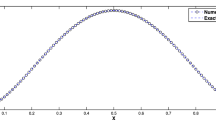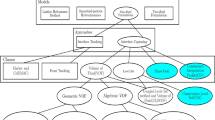Abstract
The immersed boundary method (IBM) is a well-suited tool for the direct numerical simulation of flows with dense particle suspensions, which feature strong and complex flow-particle and particle–particle interactions. With the aim to model such flows, this paper proposes to extend the Regularised Discrete Momentum Forcing (RDMF-) IBM of Abdol Azis et al. (2018) to immersed boundaries (IBs) whose motion is coupled to the flow. A modification to the direct-forcing formulation, resulting in an offset of the imposed no-slip boundary from a moving immersed boundary, is proposed. This offset is exploited in an iterative strong flow-particle coupling scheme, where the boundary forces are applied at the location of the IB known from the previous time level, while correctly enforcing the no-slip condition at the new location of the IB. This avoids having to reconstruct the interpolation and spreading stencils for every linear iteration of the flow-particle coupling, therefore reducing the computational load of the method. A technique to ensure the stable modelling of flows involving light particles is also presented and is shown to stably cope with a wide range of particle–fluid density ratios. The framework is validated by comparing the results of the simulation of a single sedimenting sphere with published experimental results. Simulations of the fluidisation of heavy rigid particles, as well as of the ascent of closely packed light particles, are also presented. Use of the radius retraction procedure, to compensate for the diffuse representation of the smooth-interface IBM, is demonstrated to consistently yield significant improvements for moving IB cases with low to intermediate Reynolds numbers. The present framework shows good stability properties for a wide range of flow regimes with concentrated particle suspensions.
Similar content being viewed by others
References
Abdol Azis, M.H., Evrard, F., van Wachem, B.: An immersed boundary method for incompressible flows in complex domains. Submitted (2018)
Abraham, F.F.: Functional dependence of drag coefficient of a sphere on Reynolds number. Phys. Fluids 13(8), 2194 (1970)
Barber, C.B., Dobkin, D.P., Huhdanpaa, H.: The quickhull algorithm for convex hulls. ACM Trans. Math. Softw. (TOMS) 22(4), 469–483 (1996)
Biegert, E., Vowinckel, B., Meiburg, E.: A collision model for grain-resolving simulations of flows over dense, mobile, polydisperse granular sediment beds. J. Comput. Phys. 340(March), 105–127 (2017)
Borazjani, I., Ge, L., Sotiropoulos, F.: Curvilinear immersed boundary method for simulating fluid structure interaction with complex 3D rigid bodies. J. Comput. Phys. 227(16), 7587–7620 (2008)
Breugem, W.-P.: A second-order accurate immersed boundary method for fully resolved simulations of particle-laden flows. J. Comput. Phys. 231(13), 4469–4498 (2012)
Causin, P., Gerbeau, J., Nobile, F.: Added-mass effect in the design of partitioned algorithms for fluid-structure problems. Comput. Methods Appl. Mech. Eng. 194(42–44), 4506–4527 (2005)
de Tullio, M., Pascazio, G.: A moving-least-squares immersed boundary method for simulating the fluid-structure interaction of elastic bodies with arbitrary thickness. J. Comput. Phys. 325(August), 201–225 (2016)
Deen, N.G., Kriebitzsch, S.H.L., van der Hoef, M.A., Kuipers, J.A.M.: Direct numerical simulation of flow and heat transfer in dense fluid–particle systems. Chem. Eng. Sci. 81, 329–344 (2012)
Denner, F., van der Heul, D.R., Oud, G.T., Villar, M.M., da Silveira Neto, A., van Wachem, B.G.M.: Comparative study of mass-conserving interface capturing frameworks for two-phase flows with surface tension. Int. J. Multiphase Flow 61, 37–47 (2014)
Glowinski, R., Pan, T., Hesla, T., Joseph, D., Périaux, J.: A fictitious domain approach to the direct numerical simulation of incompressible viscous flow past moving rigid bodies: application to particulate flow. J. Comput. Phys. 169(2), 363–426 (2001)
Haeri, S., Shrimpton, J.: On the application of immersed boundary, fictitious domain and body-conformal mesh methods to many particle multiphase flows. Int. J. Multiphase Flow 40, 38–55 (2012)
Hamming, R.W.: Stable predictor–corrector methods for ordinary differential equations. J. ACM 6(1), 37–47 (1959)
Irons, B.M., Tuck, R.C.: A version of the Aitken accelerator for computer iteration. Int. J. Numer. Methods Eng. 1(3), 275–277 (1969)
Kempe, T., Fröhlich, J.: An improved immersed boundary method with direct forcing for the simulation of particle laden flows. J. Comput. Phys. 231(9), 3663–3684 (2012)
Kempe, T., Fröhlich, J.: Collision modelling for the interface-resolved simulation of spherical particles in viscous fluids. J. Fluid Mech. 709, 445–489 (2012)
Küttler, U., Wall, W.A.: Vector extrapolation for strong coupling fluid–structure interaction solvers. J. Appl. Mech. 76(2), 021205 (2009)
Le Tallec, P.: Fluid structure interaction with large structural displacements. Comput. Methods Appl. Mech. Eng. 190(24–25), 3039–3067 (2001)
Mohaghegh, F., Udaykumar, H.S.: Comparison of sharp and smoothed interface methods for simulation of particulate flows I: fluid structure interaction for moderate Reynolds numbers. Comput. Fluids 140, 39–58 (2016)
Mohaghegh, F., Udaykumar, H.S.: Comparison of sharp and smoothed interface methods for simulation of particulate flows II: inertial and added mass effects. Comput. Fluids 143, 103–119 (2017)
Mohd-Yusof, J.: Combined immersed boundary/B-spline methods for simulation of flow in complex geometries. In: Center for Turbulence Research Annual Research Briefs, pp. 317–328 (1997)
Mordant, N., Pinton, J.F.: Velocity measurement of a settling sphere. Eur. Phys. J. B 18, 343–352 (2000)
Onural, L.: Impulse functions over curves and surfaces and their applications to diffraction. J. Math. Anal. Appl. 322(1), 18–27 (2006)
Pan, Y., Tanaka, T., Tsuji, Y.: Turbulence modulation by dispersed solid particles in rotating channel flows. Int. J. Multiphase Flow 28(4), 527–552 (2002)
Park, H., Pan, X., Lee, C., Choi, J.-I.: A pre-conditioned implicit direct forcing based immersed boundary method for incompressible viscous flows. J. Comput. Phys. 314, 774–799 (2016)
Peskin, C.S.: The immersed boundary method. Acta Numer. 11, 479–517 (2002)
Pinelli, A., Naqavi, I., Piomelli, U., Favier, J.: Immersed-boundary methods for general finite-difference and finite-volume Navier–Stokes solvers. J. Comput. Phys. 229(24), 9073–9091 (2010)
Roma, A.M., Peskin, C.S., Berger, M.J.: An adaptive version of the immersed boundary method. J. Comput. Phys. 153(2), 509–534 (1999)
Schwarz, S., Kempe, T., Fröhlich, J.: A temporal discretization scheme to compute the motion of light particles in viscous flows by an immersed boundary method. J. Comput. Phys. 281, 591–613 (2015)
Sotiropoulos, F., Yang, X.: Immersed boundary methods for simulating fluid–structure interaction. Prog. Aerosp. Sci. 65, 1–21 (2014)
Taira, K., Colonius, T.: The immersed boundary method: a projection approach. J. Comput. Phys. 225(2), 2118–2137 (2007)
ten Cate, A., Nieuwstad, C.H., Derksen, J.J., van den Akker, H.E.A.: Particle imaging velocimetry experiments and lattice-Boltzmann simulations on a single sphere settling under gravity. Phys. Fluids 14(11), 4012 (2002)
Topin, V., Dubois, F., Monerie, Y., Perales, F., Wachs, A.: Micro-rheology of dense particulate flows: application to immersed avalanches. J. Non-Newton. Fluid Mech. 166(1–2), 63–72 (2011)
Tschisgale, S., Kempe, T., Fröhlich, J.: A new approach to define a non-iterative immersed boundary method for spherical particles of arbitrary density ratio. J. Comput. Phys. 339, 432–452 (2017)
Uhlmann, M.: An immersed boundary method with direct forcing for the simulation of particulate flows. J. Comput. Phys. 209(2), 448–476 (2005)
Uhlmann, M.: Interface-resolved direct numerical simulation of vertical particulate channel flow in the turbulent regime. Phys. Fluids 20(5), 53305 (2008)
Wan, D., Turek, S.: An efficient multigrid-FEM method for the simulation of solid–liquid two phase flows. J. Comput. Appl. Math. 203(2), 561–580 (2007)
Wang, H., Chessa, J., Liu, W.K., Belytschko, T.: The immersed/fictitious element method for fluid-structure interaction: volumetric consistency, compressibility and thin members. Int. J. Numer. Methods Eng. 74(1), 32–55 (2008)
Wang, Z., Fan, J., Luo, K.: Combined multi-direct forcing and immersed boundary method for simulating flows with moving particles. Int. J. Multiphase Flow 34(3), 283–302 (2008)
Xiao, C.N., Denner, F., van Wachem, B.G.: Fully-coupled pressure-based finite-volume framework for the simulation of fluid flows at all speeds in complex geometries. J. Comput. Phys. 346, 91–130 (2017)
Yang, J., Preidikman, S., Balaras, E.: A strongly coupled, embedded-boundary method for fluid–structure interactions of elastically mounted rigid bodies. J. Fluids Struct. 24(2), 167–182 (2008)
Yang, J., Stern, F.: A simple and efficient direct forcing immersed boundary framework for fluid–structure interactions. J. Comput. Phys. 231(15), 5029–5061 (2012)
Yu, Z., Shao, X.: A direct-forcing fictitious domain method for particulate flows. J. Comput. Phys. 227(1), 292–314 (2007)
Author information
Authors and Affiliations
Corresponding author
Additional information
Publisher's Note
Springer Nature remains neutral with regard to jurisdictional claims in published maps and institutional affiliations.
Rights and permissions
About this article
Cite this article
Abdol Azis, M.H., Evrard, F. & van Wachem, B. An immersed boundary method for flows with dense particle suspensions. Acta Mech 230, 485–515 (2019). https://doi.org/10.1007/s00707-018-2296-y
Received:
Revised:
Published:
Issue Date:
DOI: https://doi.org/10.1007/s00707-018-2296-y




